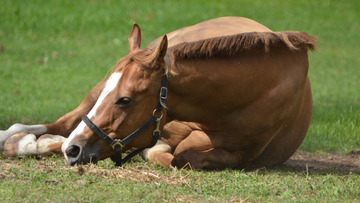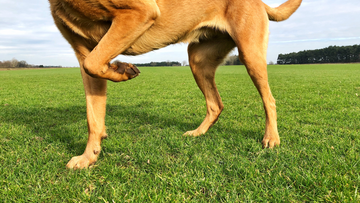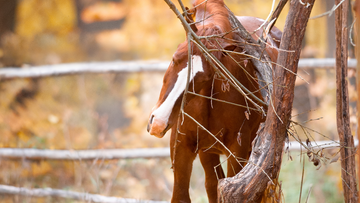 The winter causes many horse owners to be particularly cautious of their horse’s health care. The rain, ice, wind, snow and mud can cause all kinds of problems for your equine partner. Here are three common equine conditions to look for in the winter:
1. Recurrent Airway Obstruction (RAO or heaves) – RAO is a respiratory condition that can come about in many different forms. Some forms include consistent cough, asthma-like signs, and chronic breathing difficulties. This is usually caused by allergens found in hay and in barns. To avoid this, try to get your horse outside for fresh air as much as possible. If necessary, wet your horse’s bedding or hay down to keep the dust and allergens down in the barn.
2. Mud Fever and Rain Scald – Mud fever is extremely common in horses not only in the winter but also in the spring. Mud fever (aka scratches) and rain scald (aka rain rot) are caused by a bacterial infection on the outer layers of the skin. Wet and humid temperatures cause the bacteria to multiple which results in crusty lesions on the skin. The affected areas are often sore and have discharge underneath the scabs. To treat this, the areas must be scrubbed with an iodine based solution. Although it may be painful, the scabs must be removed to get to the bacteria. Be sure to disinfect all tack, rugs and grooming tools to avoid reinfection as it is very contagious.
3. Colic – Impaction colic is another common condition that occurs often in the wintertime. During the winter, inactivity, reduced water consumption and increased intake of fibrous food can all cause impaction colic. To reduce the risk of this, ensure that your horse has regular, gentle exercise and high-quality hay. Also, make sure that your horse has an ample water source throughout the day and night.
Keep an eye on your horses this winter to avoid any of these common equine conditions.
The winter causes many horse owners to be particularly cautious of their horse’s health care. The rain, ice, wind, snow and mud can cause all kinds of problems for your equine partner. Here are three common equine conditions to look for in the winter:
1. Recurrent Airway Obstruction (RAO or heaves) – RAO is a respiratory condition that can come about in many different forms. Some forms include consistent cough, asthma-like signs, and chronic breathing difficulties. This is usually caused by allergens found in hay and in barns. To avoid this, try to get your horse outside for fresh air as much as possible. If necessary, wet your horse’s bedding or hay down to keep the dust and allergens down in the barn.
2. Mud Fever and Rain Scald – Mud fever is extremely common in horses not only in the winter but also in the spring. Mud fever (aka scratches) and rain scald (aka rain rot) are caused by a bacterial infection on the outer layers of the skin. Wet and humid temperatures cause the bacteria to multiple which results in crusty lesions on the skin. The affected areas are often sore and have discharge underneath the scabs. To treat this, the areas must be scrubbed with an iodine based solution. Although it may be painful, the scabs must be removed to get to the bacteria. Be sure to disinfect all tack, rugs and grooming tools to avoid reinfection as it is very contagious.
3. Colic – Impaction colic is another common condition that occurs often in the wintertime. During the winter, inactivity, reduced water consumption and increased intake of fibrous food can all cause impaction colic. To reduce the risk of this, ensure that your horse has regular, gentle exercise and high-quality hay. Also, make sure that your horse has an ample water source throughout the day and night.
Keep an eye on your horses this winter to avoid any of these common equine conditions.
Blog
3 Common Winter Equine Conditions

 The winter causes many horse owners to be particularly cautious of their horse’s health care. The rain, ice, wind, snow and mud can cause all kinds of problems for your equine partner. Here are three common equine conditions to look for in the winter:
1. Recurrent Airway Obstruction (RAO or heaves) – RAO is a respiratory condition that can come about in many different forms. Some forms include consistent cough, asthma-like signs, and chronic breathing difficulties. This is usually caused by allergens found in hay and in barns. To avoid this, try to get your horse outside for fresh air as much as possible. If necessary, wet your horse’s bedding or hay down to keep the dust and allergens down in the barn.
2. Mud Fever and Rain Scald – Mud fever is extremely common in horses not only in the winter but also in the spring. Mud fever (aka scratches) and rain scald (aka rain rot) are caused by a bacterial infection on the outer layers of the skin. Wet and humid temperatures cause the bacteria to multiple which results in crusty lesions on the skin. The affected areas are often sore and have discharge underneath the scabs. To treat this, the areas must be scrubbed with an iodine based solution. Although it may be painful, the scabs must be removed to get to the bacteria. Be sure to disinfect all tack, rugs and grooming tools to avoid reinfection as it is very contagious.
3. Colic – Impaction colic is another common condition that occurs often in the wintertime. During the winter, inactivity, reduced water consumption and increased intake of fibrous food can all cause impaction colic. To reduce the risk of this, ensure that your horse has regular, gentle exercise and high-quality hay. Also, make sure that your horse has an ample water source throughout the day and night.
Keep an eye on your horses this winter to avoid any of these common equine conditions.
The winter causes many horse owners to be particularly cautious of their horse’s health care. The rain, ice, wind, snow and mud can cause all kinds of problems for your equine partner. Here are three common equine conditions to look for in the winter:
1. Recurrent Airway Obstruction (RAO or heaves) – RAO is a respiratory condition that can come about in many different forms. Some forms include consistent cough, asthma-like signs, and chronic breathing difficulties. This is usually caused by allergens found in hay and in barns. To avoid this, try to get your horse outside for fresh air as much as possible. If necessary, wet your horse’s bedding or hay down to keep the dust and allergens down in the barn.
2. Mud Fever and Rain Scald – Mud fever is extremely common in horses not only in the winter but also in the spring. Mud fever (aka scratches) and rain scald (aka rain rot) are caused by a bacterial infection on the outer layers of the skin. Wet and humid temperatures cause the bacteria to multiple which results in crusty lesions on the skin. The affected areas are often sore and have discharge underneath the scabs. To treat this, the areas must be scrubbed with an iodine based solution. Although it may be painful, the scabs must be removed to get to the bacteria. Be sure to disinfect all tack, rugs and grooming tools to avoid reinfection as it is very contagious.
3. Colic – Impaction colic is another common condition that occurs often in the wintertime. During the winter, inactivity, reduced water consumption and increased intake of fibrous food can all cause impaction colic. To reduce the risk of this, ensure that your horse has regular, gentle exercise and high-quality hay. Also, make sure that your horse has an ample water source throughout the day and night.
Keep an eye on your horses this winter to avoid any of these common equine conditions.





















